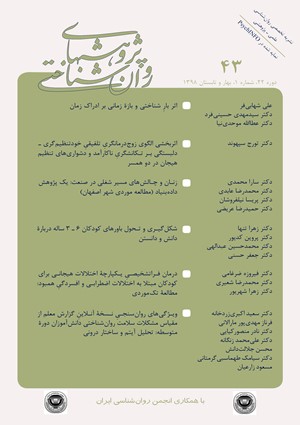درمان فراتشخیصیِ یکپارچة اختلالات هیجانی برای کودکان مبتلا به اختلالات اضطرابی و افسردگیِ همبود: مطالعة تک¬موردی
محورهای موضوعی :فیروزه ضرغامی 1 , محمدرضا شعیری 2 , زهرا شهریور 3
1 - دانشگاه شاهد
2 - دانشگاه شاهد
3 - دانشگاه علوم پزشکی تهران
کلید واژه: پروتکل یکپارچه, درمان فراتشخیصی, اضطراب, افسردگی, همبودی,
چکیده مقاله :
هدف از پژوهش حاضر، بررسی اثربخشی اولیة پروتکل جدید درمان فراتشخیصی برای اختلالات هیجانی کودکان (UP-C) بر کاهش علائم اختلالات اضطرابی و افسردگی همبود در کودکان 8 تا 11 سالة ایرانی است. در این پژوهش، پروتکل فراتشخیصیِ 15جلسه ای در چهارچوب یک طرح تجربی تک موردی با پیش آزمون، پس آزمون، و پیگیریِ یک ماهه روی یک کودک 9 سالة مبتلا به اختلال اضطراب جدایی، اختلال اضطراب اجتماعی، و اختلال افسردگی اساسی (به عنوان اختلال همبود) اجرا شد. برای جمع آوری داده ها از مصاحبة نیمه ساختاریافتة اختلالات خلقی و اسکیزوفرنیا برای کودکان، (K-SADS-PL) فهرست مشکلات رفتاری کودک، (CBCL) نسخه اصلاح شده غربالگری برای اضطراب کودکان مرتبط با اختلالات خلقی (SCARED)، و فهرست افسردگی کودکان (CDI) استفاده شد. نتایج حاصل از تحلیل نموداری ـ -ترسیمی و شاخص درصد تغییرات نشان دادند که بیمار در پایان درمان و دوره پیگیری یک ماهه، تغییرات آماری و بالینی معناداری هم در متغیرهای اضطراب و هم افسردگی (به عنوان اختلال همبود) پیدا کرد.
The purpose of the present study was to evaluate the initial efficacy of the new unified protocol of transdiagnostic treatment for children with emotional disorders (UP-C) on reducing symptoms of anxiety disorders and comorbid depression in Iranian children aged 8 to 11 years. In this study, a 15-session UP-C within a single-case experimental design with pre-test, post-test, and one-month follow-up was conducted on a 9-year-old child with separation anxiety disorder, social anxiety disorder, and major depressive disorder (as comorbid disorder). To collect data, Kiddie Schedule for Affective Disorder and Schizo-phrenia- Present and Lifetime Version (K SADS-PL), Child Behavior Checklist (CBCL), Screen for Child Anxiety Related Disorders (SCARED) and, Children Depression Invento-ry (CDI) were used. Results of graph-chart analysis and percentage change index showed that at the end of treatment and one-month follow-up period, there were significant statistical and clinical changes in both anxiety disorders and depression disorder (as comorbid disorder).


